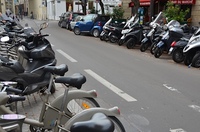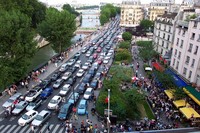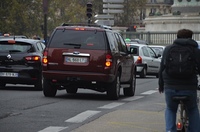Our Chicago Car Guy In France..Oui Oui
Whenever I’m in Europe I notice the absence of American cars
and other musings on travels in France.
By Larry Nutson
Senior Editor and Bureau Chief
Chicago Bureau
The Auto Channel
I’ve just returned from a ten-day visit to France. My travels
had me in Paris for four days, the city of Bordeaux for three, Arcachon on
France’s Atlantic coast for two days and back to Paris for a day
before heading home.
In this city of over 2 million the road traffic in Paris is fairly
crowded with cars and trucks along with buses for both public transit as
well as those loaded with tourists. I had joined my wife on this trip who
had business in Paris and which therefore left me on my own for a couple
days. Besides walking, I’m fairly adept at negotiating the Paris
Metro, the subway that is.
This was not my first visit to the City of Light and I’ve
previously made the observation that the cars on the streets of Paris are
almost complete void of bright colors. Parisians seem to like black, grey,
silver, a bit of dark brown and once in a while white. I also think
Parisians must not believe in washing their cars. Maybe it’s a water
conservation thing, or perhaps they don’t bother since they get dirty
right away.
Taxis and private-hire cars are mostly black. The private hire folks
do seem to believe in car washing. Paris is loaded with foreign consul
offices representing different countries. Often seen are two, three or four
car motorcades chauffeuring VIP officials around with sirens blaring and
blue lights flashing.
Now as for American cars, especially of the larger type, it’s
key to consider that the streets of Paris were laid out ages ago. Paris was
first founded in about the 3rd century BC and by the 12th century was the
largest city in the western world. Streets are fairly narrow and often a
challenge to maneuver. Plus, parking space is at a premium and often
nowhere to be found. A long or a wide vehicle is not something to have in
Paris. A vacant on-street parking space is often no bigger than the
mini-compact or subcompact car that vacated it.
Another consideration is higher fuel prices compared to what we have
in the U.S. No doubt the low crude oil prices around the globe have given
everyone’s wallet a break. Doing the math and converting liters to
gallons and Euro to U.S. dollars, a gallon of regular gasoline is about
$5.75 and it’s around $5.00 for a gallon of diesel fuel. Most cars
are diesel powered because of the lower fuel consumption and lower fuel
price.
That said, I have seen larger American cars and SUVs. On this trip a
Chrysler 300 being used as a taxi caught my eye as well as an older
generation Ford Explorer. And one evening I got a quick glimpse of a new
Mustang. But they are rarities. Being nationalistic, many Citroen, Peugeot,
and Renault cars are on the road and then of course other European brands
like Fiat, VW, Audi, BMW and Mercedes.

|

|
EVs have a bit of popularity in Paris. Short term car sharing is
available and there seems to be a fairly decent infrastructure of on-street
charging stations. The Smart car is also very prevalent, often seen parked
ninety-degrees to the curb having squeezed between two parallel-parked
cars. The Renault Twizy EV is a tandem two-seat car (or is it a
four-wheeled scooter) that makes a showing from time to time. And finally,
motor scooters galore buzz around transporting folks in every weather
condition, the riders with blanket-like tarps over their legs and laps.
Scooters and motorcycles get there own designated parking areas.

|

|
To get to Bordeaux from Paris we took France’s TGV, Train à
Grande Vitesse meaning high-speed train. The intercity train runs non-stop
between the two towns at a fairly fast clip. It takes a bit over three
hours to travel the approximate 550 km and when track conditions permit the
train travels at speeds up to 300kph, that’s 185 mph. I have a speed
App in my iPhone that uses GPS to calculate speed, so I verified the 185
mph for myself. It’s very convenient. We had reserved
seats…specific seat numbers in a specific coach of the train, and you
just show up right before the departure time. The seats are cushy and comfy
with no one complaining about you reclining the seat back, and there is
plenty of space to carry on luggage. Bring a sandwich or buy one from the
on-board catering car. There is however, no WiFi, which just may be a good
thing.

|
Bordeaux is all about wine. If you don’t drink wine perhaps
don’t visit Bordeaux, although the countryside is very beautiful. To
get around we rented a Fiat 500X from Eurocar that did the job. The 5-speed
manual transmission diesel engine “popemobile”, the 500X is
what we saw Pope Francis use during his recent U.S. visit, proved both
economical and a good performer. We put about 300 km on the Fiat and
averaged 5.8 L/100km fuel consumption. That equates to about 41 mpg.
Most of our driving was on the wine country roads leading to the
chateau vineyards around Bordeaux with speeds toping out at 70 kph, around
43 mph. We also drove from Bordeaux to Arcachon for a two-day stay. The
French highway is posted at 110 kph (67mph) near the cities and 130kph
(85mph) out in the wide open spaces. We had a Tom-Tom GPS from Eurocar that
helped us find out way.
Arcachon is a summer resort community and our late-October visit
revealed many already closed for the season homes, rental apartments and
smaller hotels. Not surprisingly like many U.S. beach resort areas we saw a
few iconic Jeeps and fun beach cars like the Citroen Mehari. Our mode of
transport was mostly by foot with a ferry to the Cap(e) Ferret area across
the Arcachon basin with its many oyster beds. We then rented bicycles to
tour the cape area for a few hours and make our way to our lunch restaurant
on the beach enjoying the view and the oysters and wine.
By foot, by train, by taxi, by bicycle, by car, by airplane
that’s how we took in a portion of France. There’s a number of
Americans who make Paris their home for a part of the year. They too get
around like we did. Like large U.S. cities, you really don’t need a
car in Paris. With taxis or the Metro at your fingertips for daily in-city
travels and outstanding train service or car-sharing easily available for a
trip to another city or our to the countryside, well, frankly, there is no
need to own a car.
On second thought, a Porsche or Ferrari for weekend vineyard tours
might be a good idea. (ed note, Might Be?)
© 2015 Larry Nutson, the Chicago Car Guy











